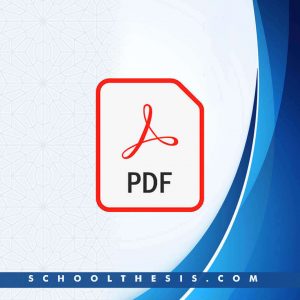
Assessment of the Profitability of Improved Agriculture and Its Relationship to Poverty Status
Quick Navigation for Final Year Undergraduates, Masters (Thesis), and Ph.D. Dissertation Students Who Need Our Services on Their Research Works
DOWNLOAD FULL PDF WORK
Abstract on Assessment of the Profitability of Improved Agriculture and Its Relationship to Poverty Status
The study was undertaken to assess the profitability of Improved Apiculture and its
Relationship to Poverty Status in Abuja, Nigeria”. A purposive sampling technique was used to purposively select 140 bee farmers from three area councils namely, Abaji, Bwari and Kwaliin the FCT. The data were analysed using descriptive statistics, Farm budgeting techniques, Foster-Greer Thorbecke (FGT) model, stochastic frontier model and Pearson correlation. Result revealed that all bee farmers in the study area were male and within the age bracket of 30-39 years with a mean age of 37. The average household size was 6. About 62.9% of the bee farmers had a secondary education, indicating that they are largely literates. The average years of farming experience was 4. About 62.9% of the farmers had contact with extension agents, about 35% had more than 40 beehives on their farm land. The calculated net farm income of beekeeping per hive of 0.7m2 in the study area was N32,514.56, also the returns to naira invested of 2.67 implies that for every N 1 invested in bee farming , a profit of N 1.67 was generated. The poverty gap index shows how far bee farming households are from the poverty line, it was estimated to be 0.39; this implies that the mean aggregate food and non-food consumption shortfall of the poor bee farmers relative to the poverty line across the whole population of bee farmers was 39% and the poor bee farmers are not too far away from the poverty line.The parameters of the stochastic frontier production function were estimated simultaneously with those of the model of inefficiency effects. Results indicated that all the variables were significant (P<0 .01=”” 52=”” 64=”” 81=”” allocative=”” and=”” annual=”” average=”” b=”” baiting=”” beekeeping=”” economic=”” efficiencies=”” efficiency=”” except=”” farmers=”” farms=”” findings=”” from=”” frontier=”” further=”” he=”” income=”” material.=”” mean=”” none=”” of=”” reached=”” respectively.=”” revealed=”” sampled=”” technical=”” that=”” the=”” threshold.however=”” was=”” were=””>N
30,9671.43) was higher than that of the beekeeping farmers income from on-farm activities (N162,212.86) and off-farm activities (N16,285.71) indicating that beekeeping contributing a higher proportion to the total income of the beekeeping farmers. Constraints highlighted were inadequate capital (69.3%), problem of theft (52.1%) amongst others. It was recommended that more extension agents should be trained on modern beekeeping so that they can effectively disseminate beekeeping information to the farmers. Beekeeping farmers should leverage beekeeping association as an avenue to access finance, inputs, technical information and market.
Chapter One of Assessment of the Profitability of Improved Agriculture and Its Relationship to Poverty Status
INTRODUCTION
Background to the Study
Apiculture (otherwise known as Beekeeping) is the art of rearing, breeding and managing honeybee colonies in artificial hives for economic gains (Ikediobiet al., 1985; Morse, 1989). It refers to the practice and management of the bees in the hives (Ojeleye, 1999; Shu‟aibet al., 2009), which leads to the production of valuable materials such as honey, beeswax, propolis, bee pollen, bee venom and royal jelly.
According to Oluwole (1999), modern bee keeping that entails housing the bees is not difficult to embark upon because investment is low, it does not require large area of land and water and there is no need for daily care. Beekeeping is an agricultural and forest based decentralized industry and does not displace persons from their villages. Bee keeping is a sustainable form of agriculture that can provide rural people with a source of much needed income and nutrition, therefore they have economic reasons to retain the natural habitat or modify it to boost honey production, and to increase yield of other agricultural products (Babatundeet al.,2007).
Poverty, on the other hand, is general scarcity, dearth, or the state of one who lacks a certain amount of material possessions or money.The poverty incidence in Nigeria increased from 65.6% in 1996 to 78.3% of the population in 2004 (FOS, 2004). Furthermore, the distribution of extreme poverty by occupational category indicates that 67.4% of thepoor in Nigeria were in agriculture (FOS, 1999). Its incidence rose from 27.2% in 1980 to 42.7% in 1992 and 69% in 2010 (NBS, 2012).
DOWNLOAD FULL PDF WORK
Disclaimer
This research material is intended for academic use only and should be used as a guide in constructing your research project and seminar presentation. You should never duplicate the content word for word (verbatim), as SCHOOLTHESIS.COM will not be held liable for anyone who does.
The purpose of publishing this material is to alleviate the stress of hopping from one school library to the next in search of research materials. This service is lawful because all educational institutions allow students to read past projects, papers, books, and articles while working on their own.
SCHOOL THESIS is merely giving this information as a research reference. Use the document as a reference or structure for your own research paper. This paper’s content should be able to assist you in coming up with new ideas and thoughts for your own study
Assessment of the Profitability of Improved Agriculture and Its Relationship to Poverty Status research paper, should only be used as a guide.

